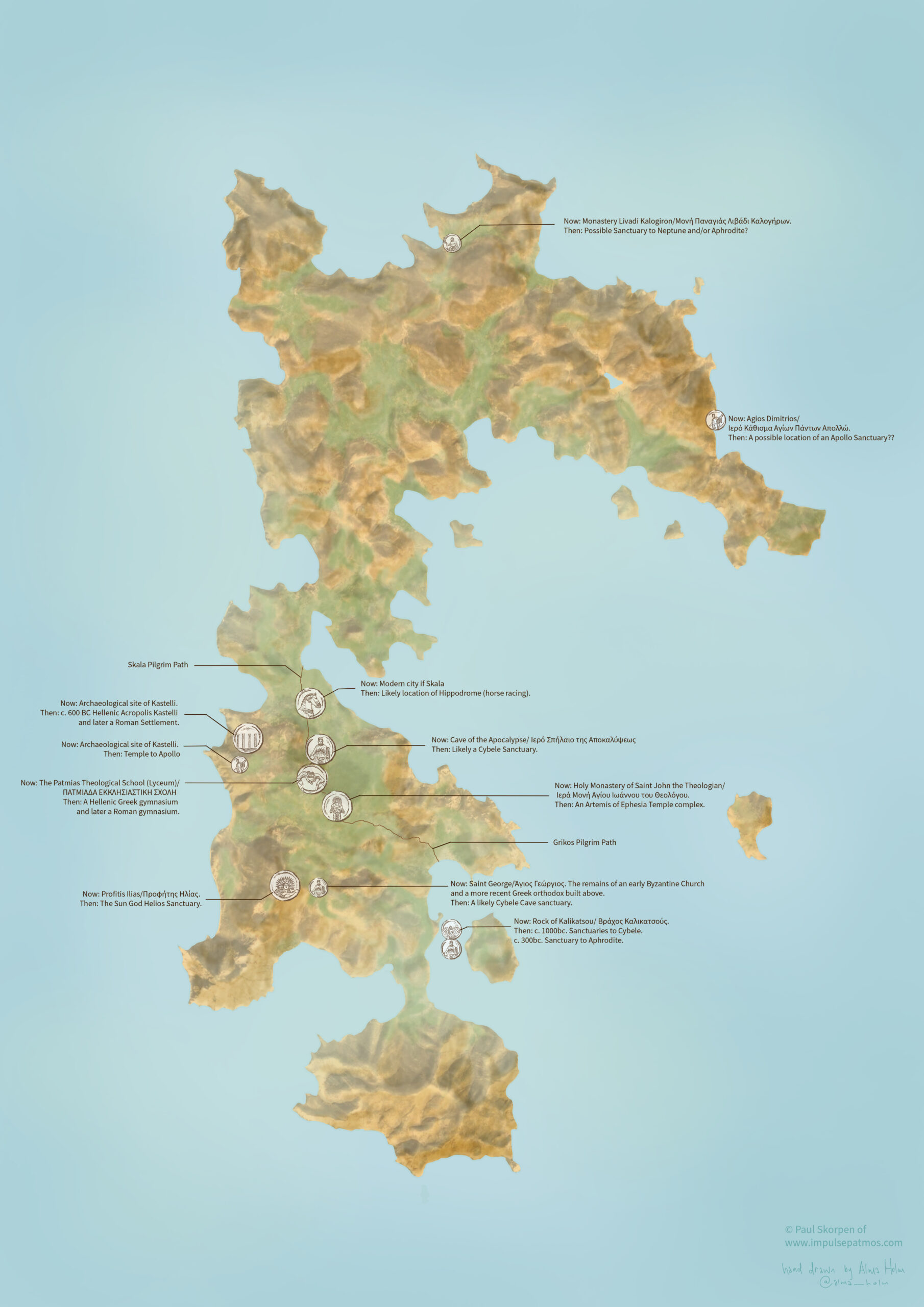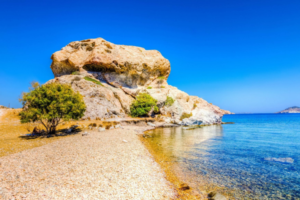 Carved steps, caves, wells for the sacred ceremonies, artificial caves to store the offerings, dark recesses surrounded by the bright blue green color of the sea and the light color of the salt marsh: A rock standing between light and shadow is the second most important archaeological site of the island. According to archaeologist Pavlos Triantafyllidis, stone tools and surface ceramics discovered in the area date back to the Late Bronze Ages (1100 BC).The rocky extremity is called “Petra of Kallikatsou” and was formed according to historic design and architecture as an outdoor temple (from 1600 BC to 4th century AD). The carvings on the rock as well as the cisterns that were necessary for the sacred ceremonies, or the small artificial caves, where the offerings were put, are still preserved. The great Anatolian Goddess Cybelle was more than likely first worshipped here as the vast nichiques carved into the bedrock were made to place Stela of the Goddess. Afterward, with the purely Hellenic folk, Aphrodite, born of the sea foam, was worshiped at site, up until the Christian times, when the carved spaces began to be used as hermitages (7th to 14th century). In the gulf of Petra you can see the remains of an early Christian building.
Carved steps, caves, wells for the sacred ceremonies, artificial caves to store the offerings, dark recesses surrounded by the bright blue green color of the sea and the light color of the salt marsh: A rock standing between light and shadow is the second most important archaeological site of the island. According to archaeologist Pavlos Triantafyllidis, stone tools and surface ceramics discovered in the area date back to the Late Bronze Ages (1100 BC).The rocky extremity is called “Petra of Kallikatsou” and was formed according to historic design and architecture as an outdoor temple (from 1600 BC to 4th century AD). The carvings on the rock as well as the cisterns that were necessary for the sacred ceremonies, or the small artificial caves, where the offerings were put, are still preserved. The great Anatolian Goddess Cybelle was more than likely first worshipped here as the vast nichiques carved into the bedrock were made to place Stela of the Goddess. Afterward, with the purely Hellenic folk, Aphrodite, born of the sea foam, was worshiped at site, up until the Christian times, when the carved spaces began to be used as hermitages (7th to 14th century). In the gulf of Petra you can see the remains of an early Christian building.
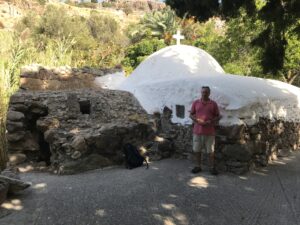 The chapel of Saint George, at the foot of Chora and on the way to Profitis Ilias, is characterised by an ancient Byzantine Chapel with a newer structure built above and to the side. The setting is idyllic with a spring allowing a lush garden to flourish. The Othodoxs believe John baptized supplicants here. Careful study of the older structure built into the bedrock predates the Byzantine period, and supports the belief that the cave-like form was used to venerate deities such as Cybele, Hecate, Demeter and Pan.
The chapel of Saint George, at the foot of Chora and on the way to Profitis Ilias, is characterised by an ancient Byzantine Chapel with a newer structure built above and to the side. The setting is idyllic with a spring allowing a lush garden to flourish. The Othodoxs believe John baptized supplicants here. Careful study of the older structure built into the bedrock predates the Byzantine period, and supports the belief that the cave-like form was used to venerate deities such as Cybele, Hecate, Demeter and Pan.
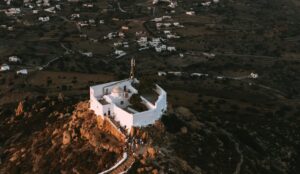
The Prophet Elias Monastery (Προφήτης Ηλίας, Prophet Elias) rises 269 metre above sea level, the most elevated point on the island. In all likelihood a much older temple once stood there to celebrate the Hellenic God Helios, the sun deity. The monastery is seldom open, but we suspects there are relics visible to a trained eye of a Helios sanctuary.
There are two Pilgrim paths leading from the shores of Skala and another from Grikos. They were use to elude pirates on your way to venerate at the temple of Artemis and later the monastery of John. The chiseled red pavement stones were first for foot traffic. The path from Skala was expanded to handle carriages.
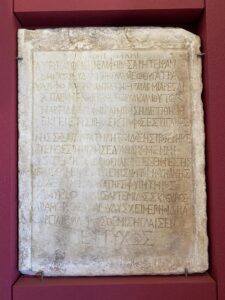 It is no secret that in the city of Chora was built to honour the Anatolia Goddess Artemis of Ephesia. There was a temple built to venerate the parton Goddess. It is unclear when it was built, but likely 600 or 400 years bc. And for long it survived the Christian zealots is also unclear. The monastery of John features many ‘recycled’ columns and capitals (all of marble) which speaks volume of an earlier incarnation of the hollowed land.
It is no secret that in the city of Chora was built to honour the Anatolia Goddess Artemis of Ephesia. There was a temple built to venerate the parton Goddess. It is unclear when it was built, but likely 600 or 400 years bc. And for long it survived the Christian zealots is also unclear. The monastery of John features many ‘recycled’ columns and capitals (all of marble) which speaks volume of an earlier incarnation of the hollowed land.
The inscription belonged to the temple of “Patmian Artemis”, which stood where the Monastery is today and reads as follows:
With good fortune. (Artemis) herself, the virgin huntress, chose as her priestess hydroforus Vera of Patmos, the noble daughter of Glaukios, to offer sacrifices of squirming new-born goats under favorable auspices. Vera was raised as a young girl in glorious Argos, but she was born and nourished in Patmos, the very venerable island of Letos’ daughter (Artemis), which emerged from the depths of the sea and became Artemis’ throne and she became its guardian, ever since the war-faring Orestes snatched her statue from Scythia and installed it here; and afterwards she calmed his terrible madness, caused by the murder of his mother. Now she, the tenth (priestess of Artemis), Vera, the daughter of the wise physician Glaukios, by the will of Scythian Artemis, crossed the perilous Aegean Sea in order to celebrate gloriously the feast and sacred meal, as the divine law prescribed. With good luck.

There is ample reason to believe the present site Patmos’ fabled theological institution, the Patmian, was built location of the Greco-Hellenic site of gymnasium (Greek: γυμνάσιον, translit. gymnásion) in Ancient Greece functioned as a training facility for competitors in public games). First of all the area, built on a hillside features large flatten surfaces, Secondly the juxtaposition to the ancient acropolis of Kastelli to the site makes it quite accessible (gymnasium in Hellenic times were often situated on the outskirts of the cities). And lastly, the Cave of the Apocalypse is just below the current Patmian. The various caves punctuating the hillside suggest the protector Goddess Cybele was venerated there, Cybele would have protected the students and athletes of the gymnasium from harm.
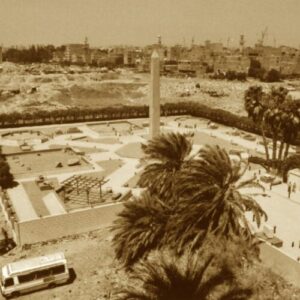
Lorem ipsum dolor sit amet, consectetur adipiscing elit. Ut at cursus ipsum. Sed sagittis massa sem, at rhoncus lectus lacinia a. Ut lacinia ultricies urna, eget fermentum quam feugiat facilisis.
Lorem ipsum dolor sit amet, consectetur adipiscing elit. Ut at cursus ipsum. Sed sagittis massa sem, at rhoncus lectus lacinia a. Ut lacinia ultricies urna, eget fermentum quam feugiat facilisis.
"Lorem ipsum dolor sit amet"
Lorem ipsum dolor sit amet, consectetur adipiscing elit. Ut at cursus ipsum. Sed sagittis massa sem, at rhoncus lectus lacinia a. Ut lacinia ultricies urna, eget fermentum quam feugiat facilisis. Maecenas eget ligula cursus, sagittis neque a, vulputate diam. Donec finibus pulvinar mi. Maecenas pellentesque vel leo et pretium. Quisque tincidunt ex sapien, blandit blandit nibh hendrerit quis. Vivamus rhoncus diam lacus, a posuere elit consequat ac. Vivamus ac mattis massa, a malesuada felis. Sed congue metus in nunc aliquet tincidunt. Maecenas suscipit justo sit amet nisi maximus, at ullamcorper mauris molestie. Sed blandit sem quis eros iaculis congue. Sed dignissim mattis turpis, sollicitudin semper arcu iaculis quis. Proin tempus sagittis sapien, id mattis lorem sollicitudin in. Vivamus quis porta enim.
Lorem ipsum dolor sit amet, consectetur adipiscing elit. Ut at cursus ipsum. Sed sagittis massa sem, at rhoncus lectus lacinia a. Ut lacinia ultricies urna, eget fermentum quam feugiat facilisis. Maecenas eget ligula cursus, sagittis neque a, vulputate diam. Donec finibus pulvinar mi. Maecenas pellentesque vel leo et pretium. Quisque tincidunt ex sapien, blandit blandit nibh hendrerit quis. Vivamus rhoncus diam lacus, a posuere elit consequat ac. Vivamus ac mattis massa, a malesuada felis. Sed congue metus in nunc aliquet tincidunt. Maecenas suscipit justo sit amet nisi maximus, at ullamcorper mauris molestie. Sed blandit sem quis eros iaculis congue. Sed dignissim mattis turpis, sollicitudin semper arcu iaculis quis. Proin tempus sagittis sapien, id mattis lorem sollicitudin in. Vivamus quis porta enim.
View VideosView Documents
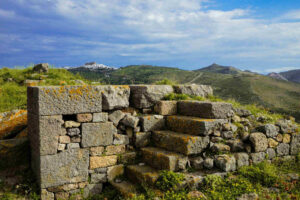 At Kastelli, a natural fortified hill to the west of Skala, evidence of continuous use has been discovered from 8th century BC – 4th century AD. Here lie ruins of the ancient Acropolis, and foundations of the Temple of Apollo and perhaps one dedicated to Dionysus. As many as 14,000 people lived on the island during the Hellenic period into the Roman.
At Kastelli, a natural fortified hill to the west of Skala, evidence of continuous use has been discovered from 8th century BC – 4th century AD. Here lie ruins of the ancient Acropolis, and foundations of the Temple of Apollo and perhaps one dedicated to Dionysus. As many as 14,000 people lived on the island during the Hellenic period into the Roman.
View VideosView Documents
<div class="videorow">
<p class="video"><iframe title="YouTube video player" src="https://www.youtube.com/embed/IxzdSOGCAwY?si=Em-nMberdRO7gmEr" width="560" height="315" frameborder="0" allowfullscreen=""></iframe></p>
</div>
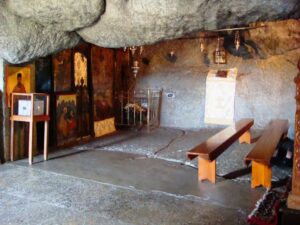 Cave of the Apocalypse, located on the picturesque Greek island of Patmos, holds immense historical and spiritual importance. This sacred cavern, believed to be where Saint John received the revelations that inspired the Book of Revelation, is a revered destination for those seeking meaningful experiences.
Cave of the Apocalypse, located on the picturesque Greek island of Patmos, holds immense historical and spiritual importance. This sacred cavern, believed to be where Saint John received the revelations that inspired the Book of Revelation, is a revered destination for those seeking meaningful experiences.
Here are several reasons why you should consider exploring this holy site:
Spiritual Depth: For devout Christians, the Cave of the Apocalypse offers a place of deep spiritual significance. Standing in the very chamber where Saint John is said to have received divine messages is an emotionally powerful experience that can strengthen one’s faith and provide a unique connection to the early days of Christianity.
Historical Richness: Beyond its spiritual importance, the cave is a true window into the past, offering visitors a glimpse into the ancient world. The simple, preserved environment, coupled with remnants of early Christian worship, provides a rare opportunity to step into the world that shaped Christianity’s foundations.
Architectural Wonder: The Holy Monastery of Saint John the Theologian, perched above the cave, is an architectural gem. Built in the 11th century, this impressive structure combines Byzantine and medieval design, showcasing the artistry and devotion of the time.
Peaceful Natural Beauty: Patmos Island is a gem of the Aegean, famous for its breathtaking scenery and peaceful atmosphere. The Cave of the Apocalypse, nestled within this natural beauty, offers a serene setting for reflection and meditation, with the Mediterranean’s tranquility as a perfect backdrop.
Inspiring Pilgrimage: For many, visiting the Cave of the Apocalypse is more than just a tourist excursion; it’s a spiritual pilgrimage. The journey to such a significant place offers a chance for introspection, spiritual growth, and a deeper connection with one’s faith.
Cultural Discovery: Visiting this sacred site also provides an opportunity for cultural exchange. Engaging with the local community, learning about the island’s traditions, and experiencing its food and customs enhance the overall visit, offering a richer understanding of Greek culture and its ties to Christianity.
Whether you’re a devout believer seeking a deeper spiritual connection, a history lover eager to experience the past firsthand, or a traveler in search of unique experiences, the Cave of the Apocalypse on Patmos promises an unforgettable journey. By exploring this remarkable site, you’ll embark not only on a physical adventure but also on a profound spiritual and cultural exploration that will leave a lasting impact on your soul.
 Editors note: There is ample evidence, quite visable, that the cave was once a place of worship for other gods and goddesses. More likely the Anatolian Goddess Cybele was venerated at the site, in the cave.
Editors note: There is ample evidence, quite visable, that the cave was once a place of worship for other gods and goddesses. More likely the Anatolian Goddess Cybele was venerated at the site, in the cave.
Here is a ceremonial cave sanctuary typical of the Greek islands and Anatolia.
 Archaeological evidence for a hippodrome has been found on Patmos, in the area between the hill of Kastelli and the harbour of Skala.
Archaeological evidence for a hippodrome has been found on Patmos, in the area between the hill of Kastelli and the harbour of Skala.
First-century Patmos, with its natural protective harbor, was a strategic island on the sea lane from Ephesus to Rome. A large administrative center, outlying villages, a hippodrome (for horse racing), and at least three pagan temples made Patmos hardly an isolated and desolate place!
Text Source.
There are two Pilgrim paths leading from the shores of Skala and another from Grikos. They were use to elude pirates on your way to venerate at the temple of Artemis and later the monastery of John. The chiseled red pavement stones were first for foot traffic. The path from Skala was expanded to handle carriages.
The Church of Agios (Saint) Dimitrios sits alone on a remote corner of the island overlooking the vast seaways and the Turkish coastland. The more ancient name of the site if 'Kathisma tou Apollou’ suggesting an ancient sanctuary of Apollo once stood on the site.
Κάθισμα Απολλώ
Βρίσκεται βορειοανατολικά του Γερανού στην περιοχή Θερμιά.
Ανοικοδομήθηκε από τον μοναχό Απολλώ και αποτελείται από έναν μικρό ιερό ναό, κελιά και περιτείχισμα. Το χαριτωμένο λιμανάκι που βρίσκεται εκεί, βγάζει από τα έγκατα της γης ζεστό νερό.
Πανηγυρίζει των Αγίων Πάντων.
<div class="videorow">
<p class="video"><iframe width="560" height="315" src="<div class="videorow">
<p class="video"><iframe width="560" height="315" src="https://www.youtube.com/embed/x4lEG1gfC-c?si=-YLEcxJvA5g7l_eP" title="YouTube video player" frameborder="0" allow="accelerometer; autoplay; clipboard-write; encrypted-media; gyroscope; picture-in-picture; web-share" referrerpolicy="strict-origin-when-cross-origin" allowfullscreen></iframe></p></div>" title="YouTube video player" frameborder="0" allow="accelerometer; autoplay; clipboard-write; encrypted-media; gyroscope; picture-in-picture; web-share" referrerpolicy="strict-origin-when-cross-origin" allowfullscreen></iframe></p></div>
Livadi Kalogiron is one of my preferred spot in the holy island of Patmos.
Its an old monastery belonging to the nunnery of Evangelismos.
It has the oldest iconostasi of the island and is simple and beautiful at the same time. The iconostasis is richly decorated.
If you poke around you see signs that a sanctuary of Aphrodite and/or Neptune once stood there, The patchwork marble flooring, a small Hellenic capital attest to earlier structure to grace the seaside paradise.
The monastery is located on the northern part of the island after the village of Kampos.
You can only go there if you have a car or a scooter.
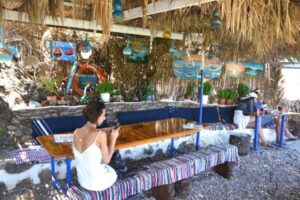
Next to the monastery there is a beach and a little taverna.
Welcome to Impulse Patmos. Enjoy our website and interactive map. Please do not reproduce without our agreement.
Hope to see you one day soon in the Land of the Tepes.
It would be our great pleasure.
Our group by the wishing tree above Göbeklitepe.
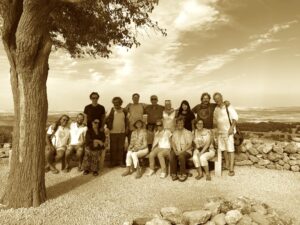
Paul Skorpen at Göbeklitepe with the Navel of the World in the background.
